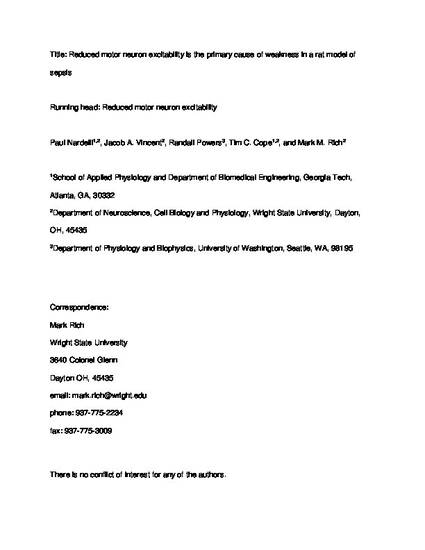
The mechanisms by which sepsis triggers intensive care unit acquired weakness (ICUAW) remain unclear. We previously identified difficulty with motor unit recruitment in patients as a novel contributor to ICUAW. To study the mechanism underlying poor recruitment of motor units we used the rat cecal ligation and puncture model of sepsis. We identified striking dysfunction of alpha motor neurons during repetitive firing. Firing was more erratic, and often intermittent. Our data raised the possibility that reduced excitability of motor neurons was a significant contributor to weakness induced by sepsis. In this study we quantified the contribution of reduced motor neuron excitability and compared its magnitude to the contributions of myopathy, neuropathy and failure of neuromuscular transmission. We injected constant depolarizing current pulses (5 s) into the soma of alpha motor neurons in the lumbosacral spinal cord of anesthetized rats to trigger repetitive firing. In response to constant depolarization, motor neurons in untreated control rats fired at steady and continuous firing rates and generated smooth and sustained tetanic motor unit force as expected. In contrast, following induction of sepsis, motor neurons were often unable to sustain firing throughout the 5 s current injection such that force production was reduced. Even when firing, motor neurons from septic rats fired erratically and discontinuously, leading to irregular production of motor unit force. Both fast and slow type motor neurons had similar disruption of excitability. We followed rats after recovery from sepsis to determine the time course of resolution of the defect in motor neuron excitability. By one week, rats appeared to have recovered from sepsis as they had no piloerection and appeared to be in no distress. The defects in motor neuron repetitive firing were still striking at 2 weeks and, although improved, were present at one month. We infer that rats suffered from weakness due to reduced motor neuron excitability for weeks after resolution of sepsis. To assess whether additional contributions from myopathy, neuropathy and defects in neuromuscular transmission contributed to the reduction in force generation, we measured whole-muscle force production in response to electrical stimulation of the muscle nerve. We found no abnormality in force generation that would suggest the presence of myopathy, neuropathy or defective neuromuscular transmission. These data suggest disruption of repetitive firing of motor neurons is an important contributor to weakness induced by sepsis in rats and raise the possibility that reduced motor neuron excitability contributes to disability that persists after resolution of sepsis.
Available at: http://works.bepress.com/timothy_cope/105/
